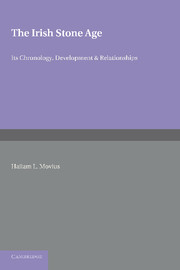Book contents
- Frontmatter
- Dedication
- Contents
- ILLUSTRATIONS
- FOREWORD
- PREFACE
- INTRODUCTION
- Part One THE CHRONOLOGY OF THE LATE-GLACIAL AND EARLY POST-GLACIAL PERIODS IN NORTHERN AND WESTERN EUROPE
- Part Two THE STONE AGE CULTURES OF IRELAND
- Appendices I-VI
- APPENDIX I The Raised Beach of the Third Interglacial Period
- APPENDIX II Deposits of the Interstadial Period between the Old and the New Drift Glaciations (W1/W2) in England and Scotland
- APPENDIX III The New Drift Glaciation
- APPENDIX IV The Recession of the Last Ice-Sheets
- APPENDIX V Deposits of the Late-Glacial Sea
- APPENDIX VI Submerged Forests and Raised Beaches in Britain and Ireland
- REFERENCES CITED IN THE TEXT
- CLASSIFIED LIST OF REFERENCES TO CAVE RESEARCH AND STONE AGE ARCHAEOLOGY IN IRELAND
- ADDENDUM
- INDEX
APPENDIX I - The Raised Beach of the Third Interglacial Period
from Appendices I-VI
Published online by Cambridge University Press: 05 June 2016
- Frontmatter
- Dedication
- Contents
- ILLUSTRATIONS
- FOREWORD
- PREFACE
- INTRODUCTION
- Part One THE CHRONOLOGY OF THE LATE-GLACIAL AND EARLY POST-GLACIAL PERIODS IN NORTHERN AND WESTERN EUROPE
- Part Two THE STONE AGE CULTURES OF IRELAND
- Appendices I-VI
- APPENDIX I The Raised Beach of the Third Interglacial Period
- APPENDIX II Deposits of the Interstadial Period between the Old and the New Drift Glaciations (W1/W2) in England and Scotland
- APPENDIX III The New Drift Glaciation
- APPENDIX IV The Recession of the Last Ice-Sheets
- APPENDIX V Deposits of the Late-Glacial Sea
- APPENDIX VI Submerged Forests and Raised Beaches in Britain and Ireland
- REFERENCES CITED IN THE TEXT
- CLASSIFIED LIST OF REFERENCES TO CAVE RESEARCH AND STONE AGE ARCHAEOLOGY IN IRELAND
- ADDENDUM
- INDEX
Summary
As mentioned in the text (see p. 29), a raised beach dating from the Third Interglacial (Riss-Würm) Period is found in Britain and Ireland south of a line shown on the map (Fig. 7, p. 58). In Ireland it extends from Achill Island, County Mayo (Wright, 1934, p. 34; 1937, p. 120), down the west coast (Wright, 1911, p. 98; Charlesworth, 1930, p. 364), along the entire southern coast, where it is especially clearly defined in County Cork (Wright and Muff, 1904, pp. 274-300), on the east coast (Martin, 1930, pp. 500- 6), in the Dublin area (Farrington, 1929, p. 169), and at Ardglass, Killough Bay, County Down (Charlesworth et al. 1935, p. 480; Martin, 1930). It is present in the Isle of Man (Wright, 1911, p. 98), Wales (George, 1932, p. 292; Jones, 1934, pp. 304—6), the south coast of England (Pengelly, 1867; Dewey, 1913; Jones, 1934, p. 307), with the exception of the Chalk region of Dover, and it appears again in Yorkshire (Wright, 1914, pp. 94 and 96). In the Channel Islands it is well marked, and at numerous localities along the coasts of Normandy and Brittany it has been identified (Wright, 1914, pp. 94—5), especially important sections existing in the vicinity of Calais (Day, 1866, p. III).
In the Gower Peninsula of Southern Wales there are two raised beaches older than Würm—the Neritoides beach and the Patella beach (George, 1932, p. 317). The latter is older and is associated with a cold fauna, whilst the former may be correlated with the bone deposits at Minchen Hole, which have yielded warm interglacial forms. The Neritoides beach is overlain by Old Drift, which indicates that its age is probably Third Interglacial, although it may be older. Certainly a Third Interglacial dating is suggested by the fauna of Minchen Hole (compare Wheeler, 1925, p. 18; B.R.G.[e], p. 109), as well as by the fact that the Gower Peninsula was ice-free during the period of the New Drift Glaciation (George, 1933, p. 208). On the opposite side of the Bristol Channel the counterpart of the Neritoides beach has been identified at several localities (Day, 1866[a], p. 116; Palmer, 1931, pp. 346-52; B.R.G.[c], p. 85). In the Severn and Avon Valleys terraces occur at heights cȯrresponding to these coastal marine platforms (Wills, 1938, pp. 232—3; Tomlinson, 1935, pp. 456—9).
- Type
- Chapter
- Information
- The Irish Stone AgeIts Chronology, Development and Relationships, pp. 265Publisher: Cambridge University PressPrint publication year: 2013



